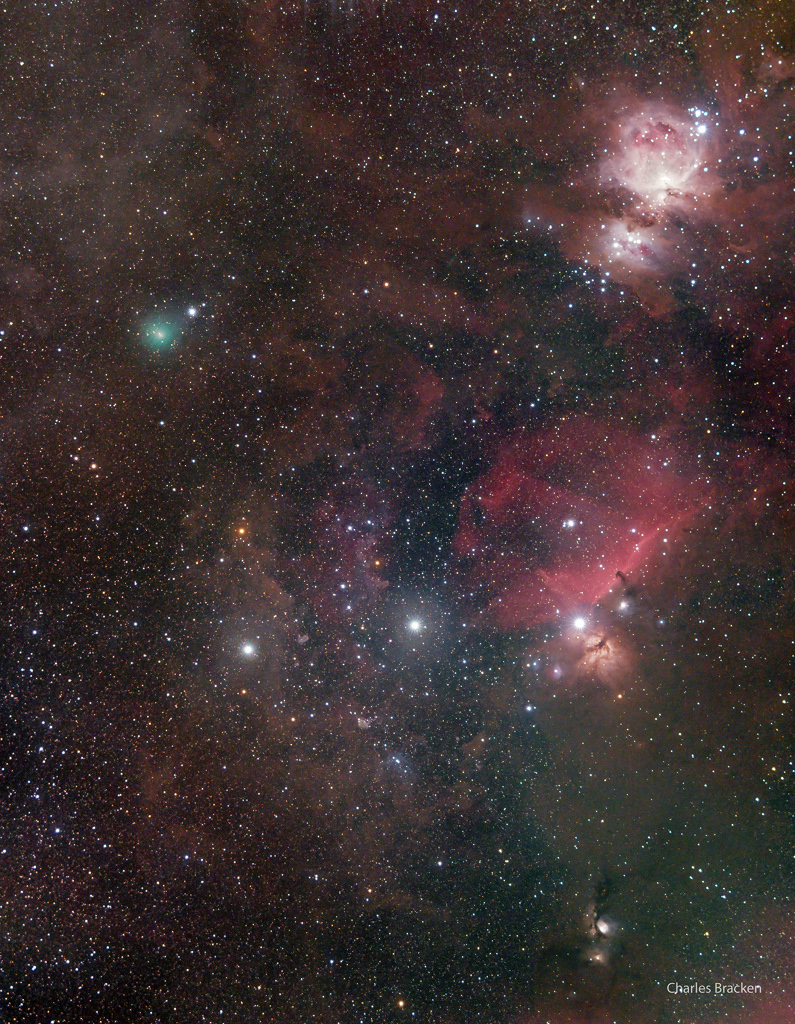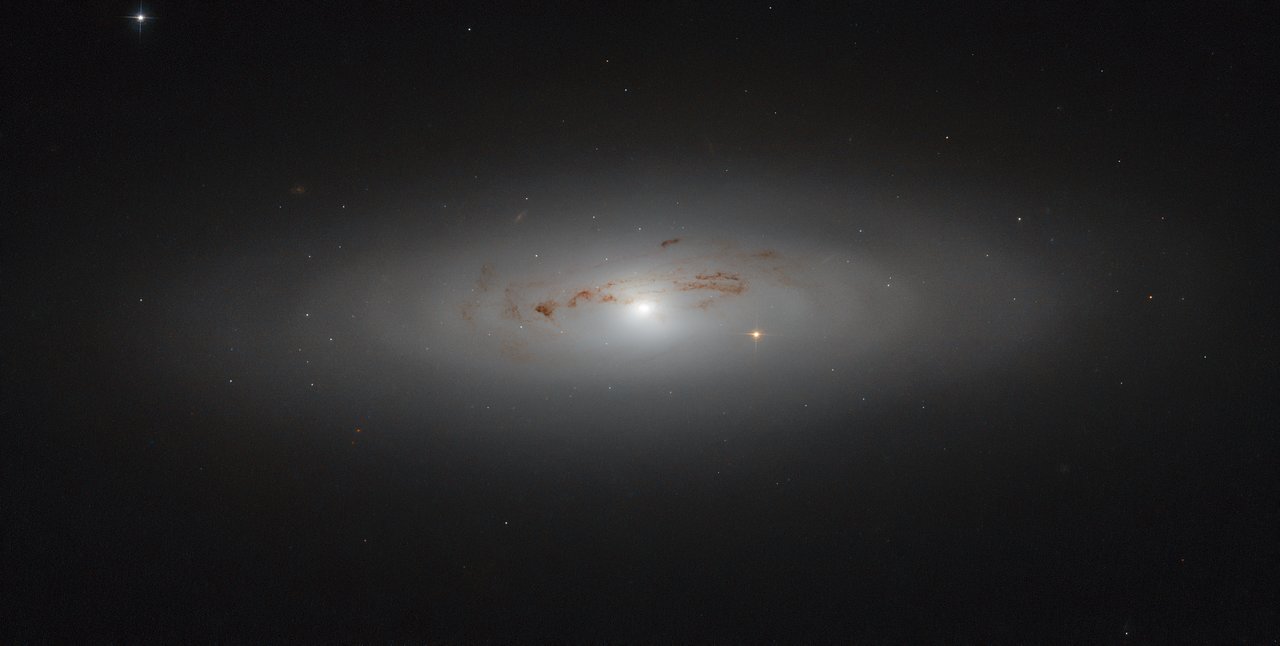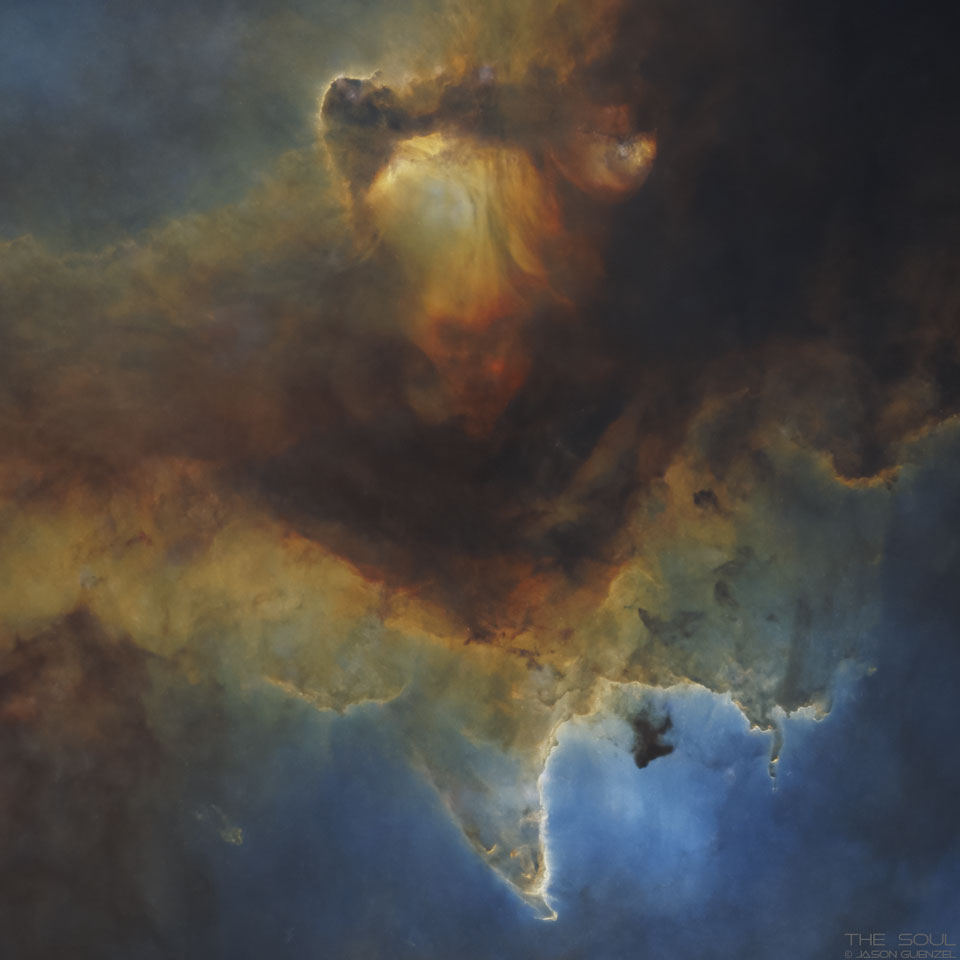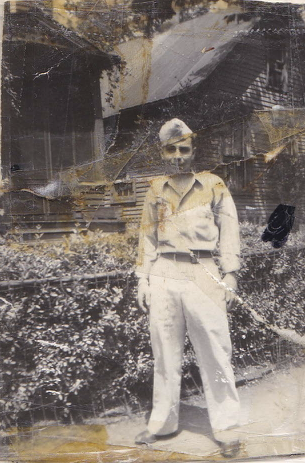With its closest approach to planet Earth scheduled for November 14, this Comet ATLAS (C/2020 M3) was discovered just this summer, another comet found by the NASA funded Asteroid Terrestrial-impact Last Alert System. It won’t get as bright as Comet NEOWISE but it can still be spotted using binoculars, as it currently sweeps through the familiar constellation of Orion. This telephoto field from November 8, blends exposures registered on the comet with exposures registered on Orion’s stars. It creates an effectively deep skyview that shows colors and details you can’t quite see though, even in binoculars. The comet’s telltale greenish coma is toward the upper left, above Orion’s three belt stars lined-up across the frame below center. You’ll also probably spot the Orion Nebula, and famous Horsehead Nebula in the stunning field of view. Of course one of Orion’s belt stars is nearly 2,000 light-years away. On November 14, this comet ATLAS will fly a mere 2.9 light-minutes from Earth.

Neil Percival Young OC OM (born November 12, 1945) is a Canadian-American singer-songwriter, musician, and activist. After embarking on a music career in the 1960s, he moved to Los Angeles, joining Buffalo Springfield with Stephen Stills, Richie Furay and others. Since his early solo albums and those with his backing band Crazy Horse, Young has been prolific, recording a steady stream of studio and live albums.
Young has received several Grammy and Juno Awards. The Rock and Roll Hall of Fame inducted him twice: in 1995 as a solo artist and in 1997 as a member of Buffalo Springfield. In 2000, Rolling Stone named Young the 34th greatest rock ‘n roll artist. His guitar work, deeply personal lyrics and signature tenor singing voice define his long career. He also plays piano and harmonica on many albums, which frequently combine folk, rock, country and other musical styles. His often distorted electric guitar playing, especially with Crazy Horse, earned him the nickname “Godfather of Grunge“ and led to his 1995 album Mirror Ball with Pearl Jam. More recently he has been backed by Promise of the Real. His 21 albums and singles have been certified Gold and Platinum in U.S by RIAA certification.
Young directed (or co-directed) films using the pseudonym Bernard Shakey, including Journey Through the Past (1973), Rust Never Sleeps (1979), Human Highway (1982), Greendale (2003), and CSNY/Déjà Vu (2008). He also contributed to the soundtracks of the films Philadelphia (1993) and Dead Man (1995).
Young has lived in California since the 1960s but retains Canadian citizenship. He was awarded the Order of Manitoba on July 14, 2006, and was made an Officer of the Order of Canada on December 30, 2009. He became a United States citizen, taking dual citizenship, on January 22, 2020.
see full post...Samuel Jones (November 12, 1924 – December 15, 1981) was an American jazz double bassist, cellist, and composer.
Sam Jones was born in Jacksonville, Florida, and moved in 1955 to New York City. There, he played with Bobby Timmons, Tiny Bradshaw, Les Jazz Modes, Kenny Dorham, Illinois Jacquet, Freddie Hubbard, Dizzy Gillespie (1958–59) and Thelonious Monk. He is probably best known for his work with Cannonball Adderley. He also spent several years working with Oscar Peterson (1966-1970) and Cedar Walton and recorded with Bill Evans in the 1950s. His career primarily revolved around the New York City jazz scene. Jones wrote the jazz standards “Del Sasser” and “Unit 7” while working with Adderley. Other compositions include “Blue Funk”, “O.P.”, “Bittersweet”, and “Seven Minds”. He died of lung cancer in 1981 at the age of 57.
see full post...Wilbur Dorsey “Buck” Clayton (November 12, 1911 – December 8, 1991 Parsons, KS) was an American jazz trumpet player who was a leading member of Count Basie‘s “Old Testament” orchestra and a leader of mainstream-oriented jam session recordings in the 1950s. His principal influence was Louis Armstrong, first hearing the record “Confessin That I Love You” on Central Avenue as he passed by a shop window.The Penguin Guide to Jazz says that he “synthesi[zed] much of the history of jazz trumpet up to his own time, with a bright brassy tone and an apparently limitless facility for melodic improvisation”. Clayton worked closely with Li Jinhui, father of Chinese popular music in Shanghai. His contributions helped change musical history in China, Hong Kong and Taiwan.
Clayton learned to play the piano from the age of six. His father was an amateur musician associated with the family’s local church, who was responsible for teaching his son the scales on a trumpet which he did not take up until his teens. From the age of seventeen, Clayton was taught the trumpet by Bob Russell, a member of George E. Lee‘s band. In his early twenties he was based in California, and was briefly a member of Duke Ellington’s Orchestra and worked with other leaders. Clayton was also taught at this time by trumpeter Mutt Carey, who later emerged as a prominent west-coast revivalist in the 1940s. He also met Armstrong while Armstrong was performing at Sebastian’s Cotton Club, who taught him how to glissando on his trumpet.
see full post...Booker T. Washington “Bukka” White (November 12, 1906 – February 26, 1977) was an American Delta blues guitarist and singer. Bukkais a phonetic spelling of White’s first name; he was named after the African-American educator and civil rights activist Booker T. Washington.
White was born south of Houston, Mississippi. He was a first cousin of B.B. King‘s mother (White’s mother and King’s grandmother were sisters). He played National resonator guitars, typically with a slide, in an open tuning. He was one of the few, along with Skip James, to use a crossnote tuning in E minor, which he may have learned, as James did, from Henry Stuckey. He also played piano, but less adeptly. White started his career playing the fiddle at square dances. He claimed to have met Charlie Patton soon after, but some have doubted this recollection. Nonetheless, Patton was a strong influence on White. “I wants to come to be a great man like Charlie Patton”, White told his friends.
He first recorded for Victor Records in 1930. His recordings for Victor, like those of many other bluesmen, included country blues and gospel music. Victor published his photograph in 1930. His gospel songs were done in the style of Blind Willie Johnson, with a female singer accentuating the last phrase of each line. From fourteen recordings, Victor released two records under the name Washington White, two gospel songs with Memphis Minnie on backing vocals and two country blues.
see full post...https://www.youtube.com/watch?v=dTZf5TjdRE0&list=PLEB3LPVcGcWZ0hsQ5_jgSMhawAnDzy1io&index=22
see full post...Delores LaVern Baker (November 11, 1929 – March 10, 1997) was an American R&B singer who had several hit records on the pop chart in the 1950s and early 1960s. Her most successful records were “Tweedle Dee” (1955), “Jim Dandy” (1956), and “I Cried a Tear” (1958).
see full post...The galaxy NGC 4036: a lenticular galaxy some 70 million light-years away in the constellation of Ursa Major (the Great Bear). This galaxy is known for its irregular lanes of dust, which form a swirling spiral pattern around the centre of the galaxy. This core is surrounded by an extended, hazy aura of gas and dust that stretches further out into space and causes the warm, fuzzy glow that can be seen here. The centre itself is also intriguing; it is something known as a LINER-type (Low-Ionisation Nuclear Emission-line Region) galactic nucleus, meaning that it displays particular emission lines within its spectrum. The particularly bright star visible slightly to the right of the galactic centre is not within the galaxy itself; it sits between us and NGC 4036, adding a burst of brightness to the scene. Due to its relative brightness, this galaxy can be seen using an amateur telescope, making it a favourite amongst backyard astronomers and astrophotography aficionados.

Walter Louis Garland (11 November 1930 – 27 December 2004) professionally Hank Garland, was an American guitarist and songwriter. He started as a country musician, played rock and roll as it became popular in the 1950s, and released a jazz album in 1960. His career was cut short when a car accident in 1961 left him unable to perform. 2007 saw the release of the Hank Garland biopic Crazy.
Born in Cowpens, South Carolina, Garland began playing guitar at the age of six. He appeared on local radio shows at 12 and was discovered at 14 at a South Carolina record store.
see full post...Ernestine Anderson (November 11, 1928 – March 10, 2016) was an American jazz and blues singer. In a career spanning more than six decades, she recorded over 30 albums. She was nominated four times for a Grammy Award. She sang at Carnegie Hall, the Kennedy Center, the Monterey Jazz Festival (six times over a 33-year span), as well as at jazz festivals all over the world. In the early 1990s she joined Qwest Records, the label founded by fellow Garfield High School graduate Quincy Jones.
Ernestine Irene Anderson (and her twin sister Josephine) were born in Houston, Texas, on November 11, 1928. Her mother, Erma, was a housewife, and her father, Joseph, a construction worker who sang bass in a gospel quartet. By the age of three, Anderson showed a talent for singing along with her parents’ old blues 78 rpm records by the likes of Bessie “The Empress of the Blues” Smith. Anderson started singing at a local church, singing solos in its gospel choir.
https://www.youtube.com/watch?v=LPGwUYOTe0Y
see full post...Mose John Allison Jr. (November 11, 1927 – November 15, 2016 Tippo, MS) was an American jazz and blues pianist, singer, and songwriter. He became notable for playing a unique mix of blues and modern jazz, both singing and playing piano. After moving to New York in 1956, he worked primarily in jazz settings, playing with jazz musicians like Stan Getz, Al Cohn, and Zoot Sims, along with producing numerous recordings.
He is described as having been “one of the finest songwriters in 20th-century blues.” His songs were strongly dependent on evoking moods, with his individualistic, “quirky”, and subtle ironic humor. His writing influence on R&B had well-known fans recording his songs, among them Pete Townshend, who recorded his “Young Man Blues” for the Who‘s Live at Leeds album in 1970. John Mayall was one of dozens who recorded his classic, “Parchman Farm“, and Georgie Fame used many of Allison’s songs. Others who recorded his songs included Leon Russell (“I’m Smashed”) and Bonnie Raitt (“Everybody’s Crying’ Mercy”).
The 1980s saw an increase in his popularity with new fans drawn to his unique blend of modern jazz. In the 1990s he began recording more consistently. Van Morrison, Georgie Fame and Ben Sidran collaborated with him on a tribute album, Tell Me Something: The Songs of Mose Allison. The Pixies wrote the song “Allison” as a tribute.
Allison’s music had an important influence on other artists, such as Jimi Hendrix, J. J. Cale, the Yardbirds, the Rolling Stones, Tom Waits, and Pete Townshend. He was inducted into the Long Island Music Hall of Fame in 2006.
see full post...This cosmic close-up looks deep inside the Soul Nebula. The dark and brooding dust clouds near the top, outlined by bright ridges of glowing gas, are cataloged as IC 1871. About 25 light-years across, the telescopic field of view spans only a small part of the much larger Heart and Soul nebulae. At an estimated distance of 6,500 light-years the star-forming complex lies within the Perseus spiral arm of our Milky Way Galaxy, seen in planet Earth’s skies toward the constellation Cassiopeia. An example of triggered star formation, the dense star-forming clouds in the Soul Nebula are themselves sculpted by the intense winds and radiation of the region’s massive young stars. In the featured image, stars have been digitally removed to highlight the commotion in the gas and dust.

see full post...
Russell Charles Means (November 10, 1939 – October 22, 2012) was an Oglala Lakota activist for the rights of Native Americans, libertarian political activist, actor, writer and musician, who became a prominent member of the American Indian Movement (AIM) after joining the organization in 1968 and helped organize notable events that attracted national and international media coverage.
Means was active in international issues of indigenous peoples, including working with groups in Central and South America and with the United Nations for recognition of their rights. He was active in politics at his native Pine Ridge Indian Reservation and at the state and national level.
Beginning an acting career in 1992, he appeared on numerous television series and in several films, including The Last of the Mohicans and released his own music CD. He published his autobiography Where White Men Fear to Tread in 1995.
see full post...Wilbert Thirkield “Big Chief” Ellis (November 10, 1914 – December 20, 1977) was an American blues pianist and vocalist.
Ellis was born in Birmingham, Alabama, United States, and was an autodidact at piano. He played at local parties and dances in the late 1920s before leaving Alabama, traveling the United States and working odd jobs. He served in the Army from 1939 to 1942, then moved to New York City, where he accompanied touring blues performers for their concerts in the city. He recordedwith Lenox Records in 1945, and recorded for Capitol Records with Sonny Terry and Brownie McGhee in the 1950s.
In 1972, Ellis moved to Washington, D.C., where he operated a liquor store. Towards the end of his life, Ellis began recording for Trix Records, where he played again with McGhee as well as Tarheel Slim and John Cephas.
Ellis died in Birmingham, Alabama, of heart failure aged 63
see full post...Hubert Laws (born November 10, 1939) is an American flutist and saxophonist with a career spanning over 40 years in jazz, classical, and other music genres. Considering the artistry of the late Eric Dolphy and the popularity of the late Herbie Mann, Laws is notably in the company of the most recognized and respected jazz flutist in the history of jazz, (also the most imitated). Laws is one of the few classical artists who has also mastered jazz, pop, and rhythm-and-blues genres, moving effortlessly from one repertory to another.
Hubert Laws, Jr. was born November 10, 1939, in the Studewood section of Houston, Texas, the second of eight children to Hubert Laws, Sr. and Miola Luverta Donahue. Many of his siblings also entered the music industry, including saxophonist Ronnie and vocalists Eloise, Debra and Johnnie Laws. He began playing flute in high school after volunteering to substitute for the school orchestra’s regular flutist. He became adept at jazz improvisation by playing in the Houston-area jazz group the Swingsters, which eventually evolved into the Modern Jazz Sextet, the Night Hawks, and The Crusaders. At age 15, he was a member of the early Jazz Crusaders while in Texas (1954–60), and also played classical music during those years.
see full post...